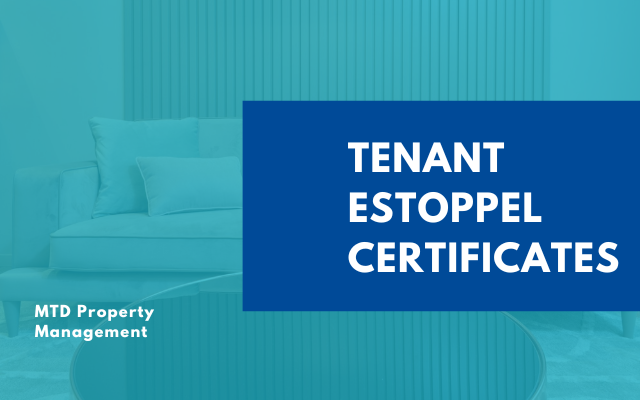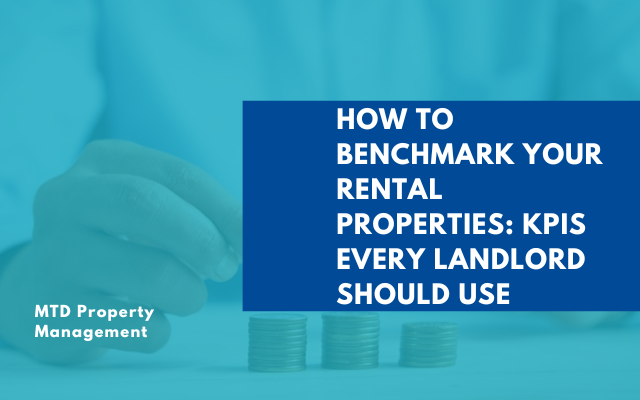
One of the simplest ways to invest in real estate is to purchase a property and then rent it out. Being a landlord comes with its fair share of responsibilities and challenges.
However, owning a rental property is a great way to earn a steady cash flow every month, while also ensuring that your investment and equity grow over time.
Getting a property ready to rent is not easy. It requires thorough inspections, plenty of maintenance and renovations, and an effective marketing strategy. To avoid this, some investors purchase properties that already have tenants. But this comes with its own set of challenges.
If you’re thinking about selling or buying a rental property that is currently leased, then you must know what a tenant estoppel certificate is.
This document plays a crucial role in real estate transactions, particularly when properties are being sold or refinanced.
In this comprehensive guide, MTD Property Management will explain to you what estoppel certificates are and when you might use them. Keep reading to learn more!
What Is a Tenant Estoppel Certificate?
An estoppel certificate is a legal document that verifies the terms, conditions, and status of an existing lease agreement.

It is commonly requested when selling or refinancing a tenant-occupied property. Its end goal is to provide assurance to potential buyers or lenders about the property's leasing status.
By signing this document, tenants confirm critical details, such as the lease terms, rent amount, end date, and any agreements made with the landlord. This prevents misunderstandings and ensures that all parties involved in the transaction have accurate information about the tenancy.
It’s important to note that, in a tenant estoppel certificate, it’s the tenant who is confirming or rectifying the details of the lease.
Landlords can draft estoppel certificates to ensure renters that the lease terms will remain the same when taking over a leased property.
However, a tenant estoppel certificate is tenants’ way to communicate with new owners or lenders the lease terms they originally agreed to. This helps prevent misunderstandings and protect tenants’ rights during the transition.
What Information Does a Tenant Estoppel Certificate Include?
A tenant estoppel certificate is a legally binding document. As such, it should include key details, such as the following:

Property Information. Such as full address with house number (and apartment number, if applicable), number of bedrooms and bathrooms, and included amenities.
- Tenant Information. It should include the tenants’ full names and contact details.
- Lease Details. Including starting and end dates.
- Rent amount. Additionally, it should provide information about late fees and additional charges.
- Security deposit details. Such as the deposit amount, requirements for a full refund, and applicable deductions.
- Payment Information. Confirmation of whether rent is up to date, any outstanding balances, and details about rent collection methods.
- Rent Increases. The estoppel should clarify whether there are any pre-agreed-upon increases scheduled.
- Evictions. The owner must provide information on the property’s eviction history, if applicable.
When May I Need a Tenant Estoppel Certificate?
A tenant estoppel certificate is typically required in the following scenarios:
- Selling a Home or a Property: When a landlord decides to sell a property occupied by tenants, buyers often request estoppel certificates to verify lease terms and tenant obligations.
- Refinancing: Lenders may require estoppel certificates as part of the due diligence process to confirm rental income and lease stability.
- Resolving Disputes: In cases of legal disputes involving lease terms, an estoppel certificate can be used to clarify contested details.
- Portfolio Management: For landlords managing multiple properties, estoppel certificates can help maintain clear records of lease terms.

How to Request Tenants to Draft an Estoppel Certificate?
Getting a tenant estoppel certificate is a necessary step when acquiring or refinancing a leased property. Here’s how you can easily request tenants to help you draft this document:
- Review the Lease Agreement: Check the lease to see if it includes a clause requiring tenants to cooperate with estoppel requests. Including this clause during tenant screening can strengthen your position when making the request.
- Communicate Clearly: Proactively communicate with your tenants about the purpose of the estoppel certificate. Explain how it verifies lease terms for property sales, refinancing, or other needs without altering their rights or obligations.
- Draft the Certificate: Providing a template or form for the Tenant Estoppel Certificate will make things easier for tenants, making them more likely to cooperate. Additionally, it ensures that the document contains all relevant lease details and complies with legal standards.
- Provide the Certificate: Deliver the document either in person, via mail, or electronically. Ensure tenants have a copy of the lease for reference while reviewing the certificate.
- Give Tenants Time for Review: Set a reasonable deadline, such as 7 to 14 days, for tenants to review, sign, and return the document. Be available to answer questions or clarify any details.
- Follow-Up: Send polite reminders as the deadline approaches. Reiterate the importance of the document for ensuring transparency and legal compliance.
- Address Concerns: If tenants express doubts or concerns, discuss them openly. Provide supporting documents or adjust minor inaccuracies in the certificate if necessary.
- Escalate if Necessary: If tenants refuse to comply, consult with an attorney. If the lease includes a cooperation clause, legal steps may be taken to enforce the request.
This structured approach ensures a smooth process and fosters trust and cooperation between landlords and tenants.
Bottom Line
Tenant estoppel certificates are key for verifying lease terms and ensuring transparency in property transactions.
They provide landlords, buyers, and lenders with crucial information, safeguard tenants’ rights, and prevent misunderstandings.
Now that you know what estoppel certificates are, what information they should include, and when they’re necessary, you can streamline the property-buying process and foster trust with new tenants.
If you need help getting a tenant estoppel certificate for a rental in Chicago, contact us at
MTD Property Management! Our team of dedicated professionals will provide guidance at every step!









